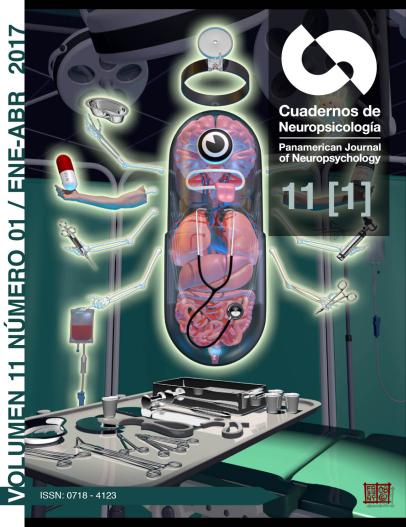Alucinaciones visuales y funcionamiento cognitivo en pacientes con déficit visual adquirido.
Abstract
Resumen
Las alucinaciones visuales son sÃntomas comunes en diversos cuadros clÃnicos. En el contexto oftalmológico se ha descrito el SÃndrome de Charles Bonnet (SCB), el cual se ha caracterizado por la presencia de alucinaciones visuales generalmente de tipo complejas en sujetos con déficit visual adquirido y sin patologÃa psicológica o psiquiátrica asociada, pudiendo distinguir la naturaleza irreal de las visiones experimentadas. El presente estudio tiene como objetivo describir la presencia de alucinaciones visuales, sus caracterÃsticas y el funcionamiento cognitivo de un grupo de pacientes con deficiencia adquirida en la agudeza visual aportando evidencia acerca de este fenómeno. Los hallazgos indican que las alucinaciones visuales de mayor frecuencia son de tipo elemental y estereotipado. Se observó en el grupo evaluado un nivel intelectual global conservado, presentando disfunción especÃfica de funciones atencionales, de memoria y ejecutivas. Se discute si estos déficits cognitivos especÃficos influyen en la manifestación de alucinaciones visuales.
Palabras claves:Â Alucinaciones visuales; deficiencia visual; funciones cognitivas, SÃndrome de Charles Bonnet.
Â
Abstract
Visual hallucinations are common symptoms in various clinical conditions. In the ophthalmological context, the Charles Bonnet Syndrome (SCB) has been described characterized by the presence of complex visual hallucinations in patients with acquired visual deficits without psychological or psychiatric comorbidity, which may distinguish the unreal nature of the visions they experience. In the present study, the visual hallucinations and cognitive functioning of a group of subjects with acquired deficiency of visual acuity are described, providing evidence concerning the characteristics of these hallucinations and cognitive functioning in this group. Our findings indicate that the more frequent visual hallucinations are of elemental and stereotypicad type. The patients, as a group, conserved a normal global intellectual level, but presented specific dysfunctions of the attentional, memory and executive functions. We discuss whether these specific cognitive deficits influence the manifestation of visual hallucinations.
Â
Keywords: Visual hallucinations; visual deficiency; cognitive functions; Charles Bonnet syndrome (CBS).
 
Resumo
Alucinações visuais são sintomas comuns em várias condições clÃnicas. No contexto oftalmológico descrito sÃndrome de Charles Bonnet (SCB), que tem sido caracterizada pela presença de alucinações visuais tipo geralmente complexo em indivÃduos com déficits visuais adquiridos sem distúrbio psicológico ou psiquiátrico associado, sendo capaz de distinguir a natureza irreal da experimentou visões. Este estudo tem como objetivo descrever a presença de alucinações visuais, suas caracterÃsticas e funcionamento cognitivo em um grupo de pacientes com deficiência adquirida na acuidade visual fornecendo evidências sobre este fenómeno. Os resultados indicam que as alucinações visuais são o tipo mais frequente de elementar e estereotipada. Observou-se no grupo avaliado a nÃvel intelectual global, conservada, apresentando disfunção especÃfico de funções de atenção, memória e executivo. Discute se esses déficits cognitivos especÃficos influenciar a manifestação de alucinações visuais.
Palavras-chave: alucinações visuais; deficiência visual; funções cognitivas, SÃndrome de Charles Bonnet.
Downloads
How to Cite
Issue
Section
License
Articles published in this journal are protected under the Creative Commons Attribution-NonCommercial-ShareAlike 4.0 International (CC BY-NC-SA 4.0) license. This means that authors retain full rights over their research and publications at all times. As a journal, we fully respect and promote the principles of open access established by this license, allowing the work to be shared, adapted, and distributed for non-commercial purposes, provided that appropriate credit is given to the authors and any derivative works are licensed under the same terms.
Authors are responsible for obtaining the required permission when they wish to reproduce part of the material (figures, etc.) from other publications.
Likewise, CNPs allows authors to host in their personal sites or other repositories that they deem convenient the Final and Definitive Version of the published article with the format assigned by the journal. In no case do we allow access to preprints of the article under evaluation or already published.
When submitting an article to CNPs you are aware that all the contents of CNPs are under a Creative Commons License. In which it is allowed to copy and share the contents freely, always making reference to the origin of the publication and its author.





